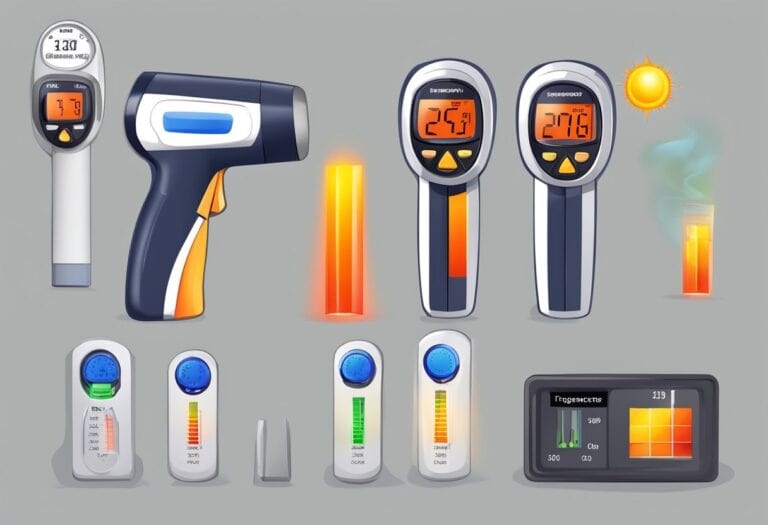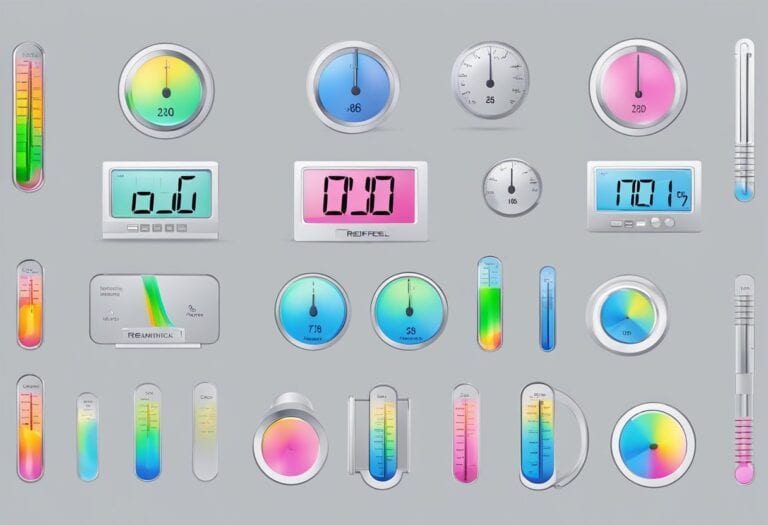When evaluating weather stations, two critical concepts often come to the fore: accuracy and precision.
Accuracy refers to how close the measurements a weather station takes are to the standard or known values, essentially a measure of correctness. On the other hand, precision is about the repeatability of measurements, or how consistently a weather station can produce the same results under the same conditions.
The distinction between these two is paramount when choosing a weather station, especially since their roles can considerably impact your data’s reliability. While a professional weather station might be an ideal choice for highly accurate data, the increasing availability and sophistication of home weather stations have made personal weather monitoring a feasible option for enthusiasts and professionals alike.
Regardless of the type, proper installation and setup are crucial to ensure that the readings are not only precise but also accurate.
Accuracy and precision – the weather wizard’s twin swords! Accuracy hits the bullseye, closeness to truth its aim. Precision repeats the feat, consistency its claim. Weather stations wield both, from home gauges to pros, whispering secrets of winds and rain, each reading a brushstroke in the sky’s ever-changing canvas.
Understanding Weather Stations

Weather stations are essential tools for capturing a variety of atmospheric data. Your understanding of these complex systems is vital in distinguishing between the numerous models and features available to ensure you invest in a quality weather station that’s suitable for your needs.
Components of a Weather Station
Each weather station consists of several key sensors that collect data on outdoor conditions. These are the fundamental parts:
- Thermometer: Measures air temperature.
- Hygrometer: Records humidity levels.
- Barometer: Monitors barometric pressure, essential for forecasting weather changes.
- Rain Gauge: Collects and measures precipitation.
- Anemometer: Gauges wind speed, often featuring a cup anemometer for precision.
- Wind Vane: Determines wind direction.
High-end stations like Davis Instruments Vantage Vue or Ambient Weather WS-2000 also include solar radiation sensors and UV index sensors for enhanced readings.
Types of Weather Stations
Weather stations vary in connectivity and display options:
- Digital Weather Stations: Offer precise readings through an LCD display which can usually be read directly or through a connected device like a smartphone or tablet.
- Wireless (or Wi-Fi) Weather Stations: Such as the Ambient Weather WS-2902 or WeatherFlow Tempest, allow for remote monitoring and real-time data updating on your personal devices without the need for physical cables.
- Home Weather Stations: Like the KestrelMet 6000, are designed for personal use, providing localized weather data directly to your home network.
Smart Weather Stations: Integrate with smart home systems, allowing for voice-activated features and data integration with other smart devices.
Making the choice for the best home weather station depends on your desired features, connectivity options, and which weather variables are most important for your monitoring activities.
Key Metrics and Measurement
In weather monitoring, the accuracy of key metrics determines the reliability of data, which is crucial for applications ranging from climate research to daily weather forecasting. Advanced sensors now capture a multitude of data in real time, offering detailed insights into weather changes.
Temperature Measurement
The precision of temperature sensors is pivotal. Your outdoor temperature reading relies on sensors with a wide temperature range to ensure accurate real-time data. Whether monitoring indoor temperature or assessing extreme weather, the temperature measurement must reflect subtle fluctuations to inform about temperature changes.
Humidity Assessment
Humidity is measured in terms of the concentration of water vapor in the air. It is important to distinguish between indoor and outdoor humidity levels. Accurate humidity sensors contribute to reliable heat index and dew point calculations, indicators that combine temperature and humidity data to comprehend the weather.
Rainfall Tracking
The amount of rain is collected via a rain gauge. Precision in rainfall measurements is critical for understanding precipitation patterns. Whether you’re tracking light drizzles or heavy downpours, it is essential that the rain gauge records the data accurately to reflect the weather change.
Wind Analysis
Assessing wind speed and wind direction is done with an anemometer. Wind analysis must capture both the sustainable wind flow and sudden wind gusts. The data is vital for the calculation of wind chill, a metric reflecting the perceived decrease in air temperature felt by the skin due to wind.
Atmospheric Pressure Monitoring
Barometric pressure is a key metric in predicting weather changes. Precision in pressure monitoring helps anticipate storm systems and weather fronts. A reliable barometric pressure sensor provides insights into the dynamics of the atmosphere and weather forecasting.
Advanced Metrics
Beyond basic measurements, sensors now capture UV and solar radiation, essential for studying climate and ecological changes. Soil moisture gauges are likewise integral for agricultural applications. These advanced metrics are enhanced by high-precision tools, advancing our understanding of complex weather phenomena.
Accuracy and Precision
The precision and accuracy of your weather station are critical for providing reliable readings and making informed decisions based on weather data. Your understanding of these concepts shapes the value of the information displayed on the digital display.
Importance of Accurate Readings
Accurate readings are the bedrock of useful weather data. When your weather station reports data with high accuracy, it means that the readings closely reflect the true environmental conditions. This precision is paramount for applications such as agriculture or research, where decisions are influenced by slight changes in weather patterns.
Understanding Precision
While accuracy denotes the closeness of your readings to the true values, precision refers to the consistency of repeated measurements. A quality weather station can consistently replicate the same readings under unchanged conditions. High precision in weather stations means that every measurement of temperature, humidity, or wind speed is consistent across multiple observations.
Calibration and Maintenance
Calibration is the process of adjusting your weather station’s sensors to ensure accurate readings. Regular maintenance is crucial for long-term reliability and involves troubleshooting and resolving issues that might affect data accuracy or precision. Understand that without periodic calibration, even the most advanced sensors can drift from their true values.
Sensor Quality and Performance
The durability and reliability of your weather station depend significantly on the quality of its sensors. High-quality sensors such as those for humidity must maintain accuracy and precision under a variety of environmental conditions. Always consider a weather station’s track record for sensor accuracy and its capacity for consistent, reliable readings when assessing different models.
Installation and Setup
When setting up your weather station, accuracy and precision depend heavily on the proper installation and initial setup. This process is fundamental to ensure reliable data collection and integration with smart home systems for ease of monitoring.
Choosing a Location
Select a location for your weather station that is free from obstructions to capture accurate ambient weather conditions. The installation site should allow for unimpeded airflow; for example, installing your station at least 4 feet above the ground and away from buildings, trees, or other tall structures. When mounting on a mounting pole, ensure that it is securely fastened and check if the weather station manufacturer recommends or provides a specific type of pole for optimal performance.
- Best Practices for Mounting:
- Height: Install at least 4 feet above the ground.
- Clearance: Keep a distance from tall obstructions.
- Orientation: Align with the prevailing wind direction for wind measurements.
Connection and Power Considerations
To ensure ease of use and features functionality, you must account for power source and connectivity during installation. Weather stations often have a wireless capability to connect to Wi-Fi, allowing you to track weather data via smartphone, tablet, or computer. A reliable power source, whether solar-charged batteries or a mains supply, is crucial to avoid data loss.
Connectivity Checklist:
- Wi-Fi Network: Confirm stable and strong Wi-Fi signal coverage at the installation site.
- Power Source: Choose a sustainable power source suitable for your location and weather station model.
- Smart Home Compatibility: Verify if your weather station supports IFTTT or other smart home platforms for seamless integration.
By attentively following these guidelines, you can establish a robust foundation for your weather station, providing you with precise and trustworthy data.
Data Management and Connectivity
In the realm of weather station technology, data management and connectivity are pivotal elements that determine how efficiently and effectively you can access and utilize weather data. These aspects cover how data is displayed, integrated, exported, and used to trigger alerts.
Data Display and Accessibility
Your weather station’s LCD display is essential for on-site data reading, offering immediate visibility into ambient weather conditions. For enhanced accessibility, many weather stations now feature companion apps for your smartphone or tablet, allowing you to view real-time data on the go. This remote access means you can monitor conditions anytime, anywhere.
Integration with Weather Services
Integrate your weather station with popular services like Weather Underground to contribute to a larger network of weather data. This provides you with broader climate trends beyond your local data. Additionally, many weather stations support smart home integration, enabling compatibility with Alexa or IFTTT, for a seamless smart home experience.
Exporting and Sharing Weather Data
The ability to export weather data is crucial for analysis and record-keeping. You can usually do this directly from the weather station’s digital display or through its app. The data can often be downloaded onto your computer in various formats for sharing or personal use.
Alerts and Notifications
Stay informed with customizable alerts and notifications that you can conveniently receive on your devices. A sudden change in weather can trigger real-time notifications, so you can act promptly, ensuring that you’re never caught unaware by a weather event. These alerts can be tailored to the thresholds you care about most, whether it’s a freeze warning or high wind speeds.
By paying close attention to the data management and connectivity features of your weather station, you harness the power to maximize the precision and accuracy of the weather data collected, making it a more reliable tool for your personal or professional meteorological needs.
Frequently Asked Questions
In this section, you’ll find a deeper insight into how various elements affect the precision and accuracy of weather stations, ensuring that you understand the subtleties of meteorological measurements.
What factors influence the accuracy of a weather station’s measurements?
The accuracy of a weather station’s measurements is influenced by factors such as sensor quality, siting, maintenance, and environmental conditions. Accurate sensors correctly reflect the true weather conditions, while proper siting away from obstructions prevents data distortion.
How does calibration impact the precision of a weather station?
Calibration is critical to the precision of a weather station. It involves adjusting the measurement process to ensure the output accurately reflects the true value. Regular calibration can significantly reduce errors and improve data precision.
Can you compare the accuracy of personal weather stations versus professional-grade stations?
Personal weather stations and professional-grade stations differ in accuracy due to the quality of instrumentation and maintenance practices. Professional stations typically have more sophisticated equipment and strict calibration protocols, achieving higher accuracy.
What technologies or methods improve the precision of weather forecasting?
Technologies such as machine learning algorithms and high-quality predictive models enhance the precision of weather forecasts by analyzing vast amounts of meteorological data to predict outcomes more reliably. The integration of real-time data from various sources also bolsters precision.
How can one assess the reliability of a weather station’s temperature readings?
To assess the reliability of a weather station’s temperature readings, examine the station’s calibration certificates, maintenance records, and whether the station uses properly shielded and ventilated sensors to prevent inaccurate readings due to radiative heating or reflection.
What are common misconceptions about a weather station’s accuracy and precision?
A common misconception is that a single reading determines a weather station’s accuracy and precision. In reality, consistent performance over time and under various conditions is a better indicator. Additionally, higher precision does not always equate to higher accuracy.







